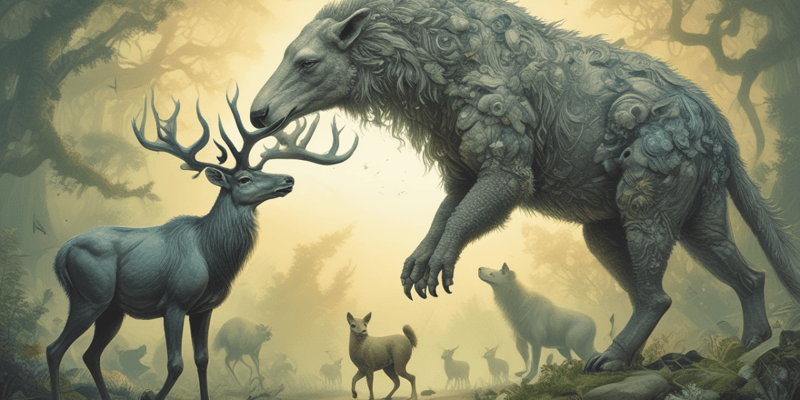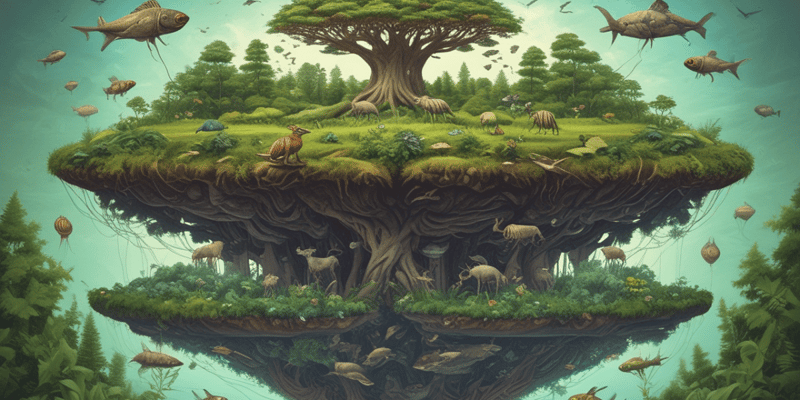Podcast
Questions and Answers
Birds have a good sense of smell.
Birds have a good sense of smell.
False
Bat-pollinated flowers are usually colorful to attract bats during the day.
Bat-pollinated flowers are usually colorful to attract bats during the day.
False
Nectar is produced in special flower glands called nectaries.
Nectar is produced in special flower glands called nectaries.
True
Pollen is low in protein, making it unattractive to bees and beetles.
Pollen is low in protein, making it unattractive to bees and beetles.
Signup and view all the answers
Flowers can only produce one kind of pollen, which is sticky.
Flowers can only produce one kind of pollen, which is sticky.
Signup and view all the answers
Bats have excellent vision and can see various colors such as red and yellow.
Bats have excellent vision and can see various colors such as red and yellow.
Signup and view all the answers
Honeycreepers have long, curved beaks that developed through co-evolution with tubular flowers.
Honeycreepers have long, curved beaks that developed through co-evolution with tubular flowers.
Signup and view all the answers
Wind pollination is a very efficient method due to precise targeting of specific flowers by the wind.
Wind pollination is a very efficient method due to precise targeting of specific flowers by the wind.
Signup and view all the answers
Flowering plants use bright colors and stripes to attract insect pollinators like bees and butterflies.
Flowering plants use bright colors and stripes to attract insect pollinators like bees and butterflies.
Signup and view all the answers
Zoophily involves animal pollinators like hummingbirds and bats, but not mammals like monkeys.
Zoophily involves animal pollinators like hummingbirds and bats, but not mammals like monkeys.
Signup and view all the answers
Plants seeking to attract bird pollinators are typically blue and ultraviolet in color.
Plants seeking to attract bird pollinators are typically blue and ultraviolet in color.
Signup and view all the answers
Insects are attracted to flowering plants through the sense of smell as they hone in on the plant's scent to extract nectar.
Insects are attracted to flowering plants through the sense of smell as they hone in on the plant's scent to extract nectar.
Signup and view all the answers
Pollen is rich in protein while nectar is composed of carbohydrates.
Pollen is rich in protein while nectar is composed of carbohydrates.
Signup and view all the answers
Certain orchids mimic female wasps to attract male wasps for pollination.
Certain orchids mimic female wasps to attract male wasps for pollination.
Signup and view all the answers
Plants in families like Naiadaceae and Hydrocharitaceae have adapted to underwater pollination.
Plants in families like Naiadaceae and Hydrocharitaceae have adapted to underwater pollination.
Signup and view all the answers
Wind-pollinated plants usually have large, showy flowers with abundant pollen.
Wind-pollinated plants usually have large, showy flowers with abundant pollen.
Signup and view all the answers
Insect pollinated flowers often produce strong scents to attract pollinators.
Insect pollinated flowers often produce strong scents to attract pollinators.
Signup and view all the answers
Animal pollination can involve coevolution between plants and their pollinators.
Animal pollination can involve coevolution between plants and their pollinators.
Signup and view all the answers
Study Notes
Coevolution and Pollination
- Coevolution is responsible for the long, curved beaks of honeycreepers, which insert their beaks into tubular flowers to obtain nectar.
- Long tubular corollas of flowers that honeycreepers visit also developed through co-evolution.
Agents of Pollination
- Wind pollination is used by gymnosperms and some flowering plants, such as grasses and trees.
- Wind pollination is not a very efficient method, as it relies on chance and can be wasteful.
- Examples of wind pollination include hazel staminate flowers releasing clouds of pollen grains.
Animal Pollinators
- Insects: bees, wasps, flies, butterflies, and moths
- Birds: hummingbirds, honeycreepers
- Mammals: bats, mice, monkeys
- Some reptiles and amphibians also act as pollinators
Coevolution and Attraction of Pollinators
- Flowering plants have evolved distinct visual cues, such as bright colors, stripes, and patterns, to attract specific pollinators.
- Examples: blue and ultraviolet colors for insects, red and orange for birds.
- Scent is also used to attract pollinators, with the scent becoming stronger and closer to the plant.
- This is metabolically more expensive for the plant, as pollen is rich in protein and nectar is composed of carbohydrates.
Plant Mimicry
- Some plants take advantage of the sex drive of insects, such as certain orchids that look and smell like female insects.
- Male insects try to mate with the flower, resulting in pollination.
Fertilization
- Fertilization occurs through the union of female and male gametes.
- Parts of a flower include: petal, anther, stamen, filament, receptacle, ovary, and ovule.
Agents of Cross-Pollination
- Water (hydrophily) is used by certain plants, such as those in the families of Naiadaceae, Ceratophyllaceae, and Potamoghentonaceae.
- Pollination takes place either underwater (hypohydrogamous) or on the water surface (epihydrogamous).
Alteration of Generation
- The alteration of generation refers to the sequence of sexual and asexual phases in an organism's life cycle.
Pollination and Reward
- Animals pollinate plants in exchange for food, such as nectar.
- Nectar is a sugary solution produced in special flower glands called nectaries.
- Nectar concentration matches the energy requirements of the pollinator.
- Pollen is high in protein and some bees and beetles eat it.
Floral and Extra-Floral Nectaries
- Floral nectaries are found in flowers and produce nectar.
- Extra-floral nectaries are found outside of flowers and produce nectar.
Getting the Attention of Pollinators
- Colors: bees see blue, yellow, and UV, while birds see red and yellow. Bats do not see well, so flowers are often white.
- Nectar or honey guides: visual cues for pollinators to locate the reward.
- Aromas: can also be carrion or dung smell, guiding pollinators to the reward.
- Edible decoy stamens: some flowers do not produce nectar, so pollinators eat part of the stamens and pollen instead.
Studying That Suits You
Use AI to generate personalized quizzes and flashcards to suit your learning preferences.
Description
Explore the concept of coevolution between honeycreepers and long tubular corollas of flowers, where the birds' beaks have evolved to obtain nectar from these specific flowers. Learn about the interdependent relationship between the plant and the bird in this fascinating process.




